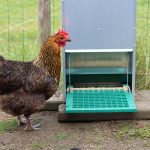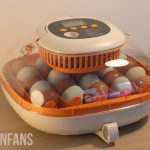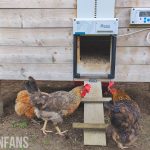Chicken Coops: Complete Guide (2024)
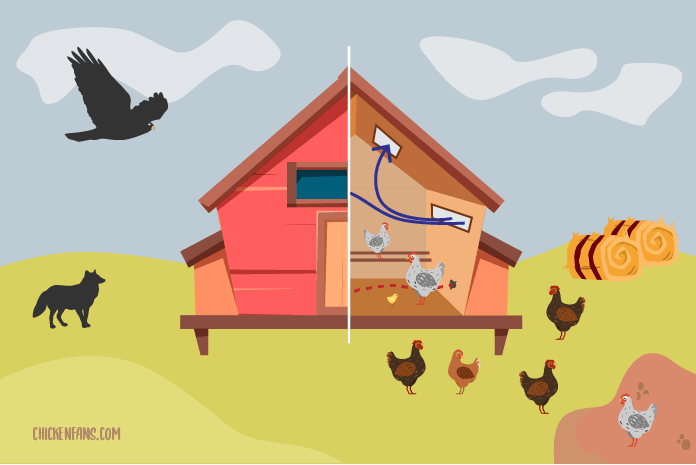
This is a complete guide to Chicken Coops.
So if you have a chicken coop or need one, this guide has everything in it for you.
Let’s dive in.
What type of Chicken Coops are there?
If you’re looking at chicken coops, the options range from extra small to full-size buildings.
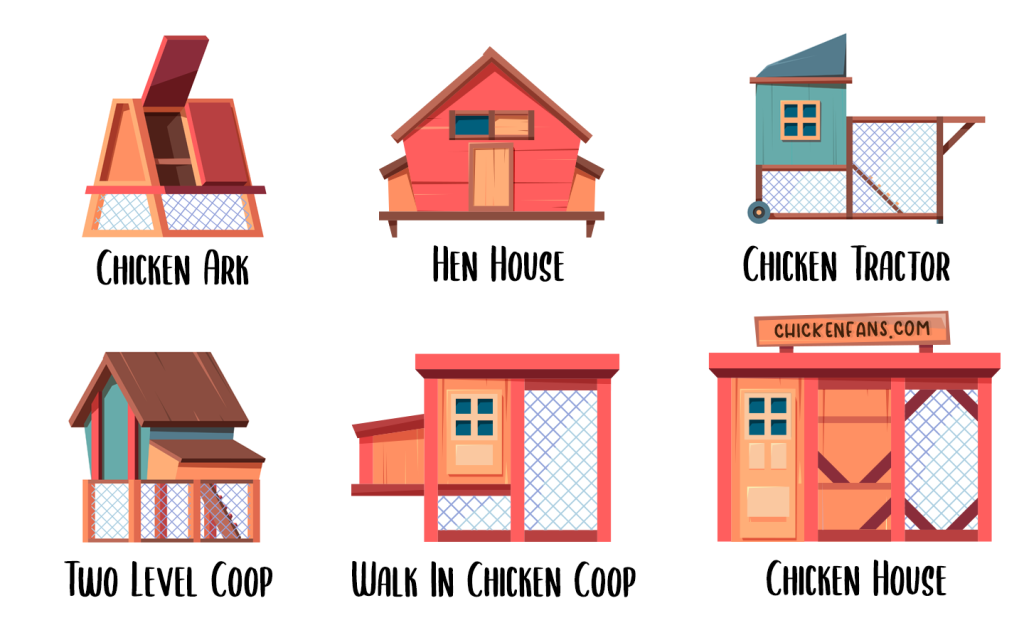
The main difference is the number of chickens they can host.
- Chicken Ark
The smallest solution to keep your chickens confined. An ark can usually host two to four chickens. Ideal for moving your chicks out in the garden or to house some Bantams or small breeds. Since it’s so small, it can easily be moved around the garden. - Hen House
A classic chicken coop that can be combined with a chicken run or free-range. They come in different sizes, but the larger ones can accommodate up to 6 hens. A good hen house should provide shelter and should be easy to maintain: it should be easy to get the eggs and replace the bedding. - Chicken Tractor
A tractor is a portable chicken coop with wheels. It’s called a ‘tractor’ because the chickens like to dig the grass and turn over the soil. - Two Level Coop
Larger coops frequently foresee multiple stories. It provides some extra shelter under the coop. The hens can live their luxurious life in the bel étage. Coops are elevated to prevent water infiltration and to provide extra protection from predators. - Walk-In Chicken Coop
Now we’re getting into the bigger coops, where you can just walk in. They can host a plethora of chickens and you can go as big as you want. They are easy to enter, and the chickens usually also get some more free height to roost. - Chicken House
Some people are building small houses in their backyards to house the chickens. We can only encourage this!
Any larger and we are entering the area of poultry farming.
If you are looking for a chicken coop, choose a suitable type for the size of your flock. Once you’ve chosen the perfect chicken coop, why not give your coop a fun name?
We’ve compiled a HUGE list of chicken coop name ideas, from clever wordplay to pop culture references and thematic inspirations. Ideal for adding character and a sense of identity to your backyard oasis!
Okay, but how much space do chickens need?
That’s, of course, the million-dollar question.
As a rule of thumb, foresee at least 3 to 5 square feet per chicken in the chicken coop and provide a minimum of 10 square feet per chicken in the run.
So if you have six chickens, this would give you a minimum of 18 square feet for housing and 60 square feet for stretching their legs.
You can use our chicken coop size calculator to calculate the size you need for the chicken coop and run depending on the number of chickens and bantams you have in your flock.
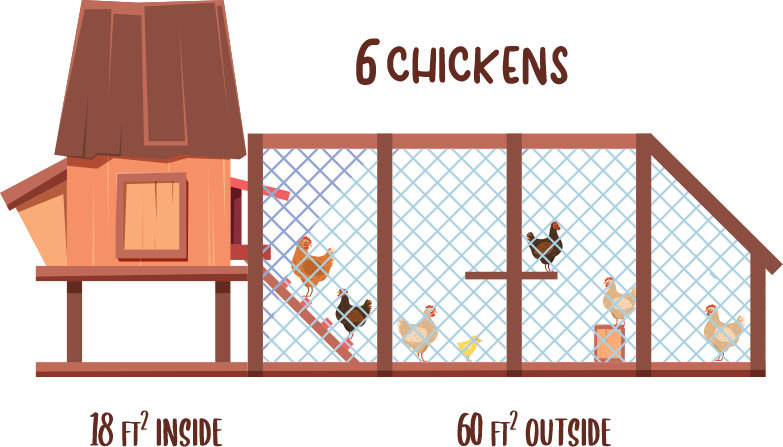
These are guidelines. Not every flock is the same. Brahmas and Orpingtons need more space than Silkies. If the coop is too small, the hens will get grumpy and start pecking each other.
Just to be clear: more space is better.
Chickens are the most abused animals on the planet. In poultry farms worldwide, layer hens and broilers are surviving in extreme forms of confinement with windowless sheds and artificial lightning.
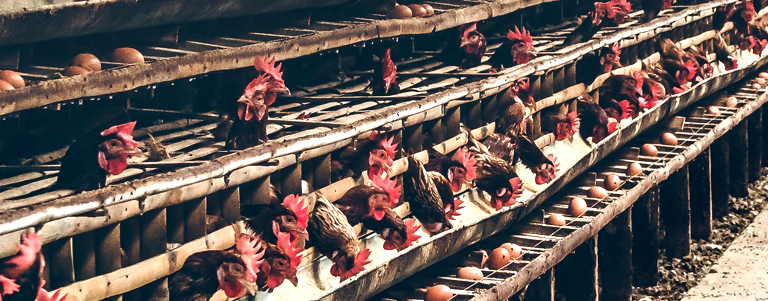
Give your hens some space and love.
Let’s see how you can do that by providing everything they need in the chicken coop.
The Chicken Coop
The coop needs to be a safe place for the flock to sleep, lay eggs and be free from stress. Most chicken owners choose a traditional wooden coop, but plastic chicken coops, like Omlet Eglu Cube, are gaining in popularity because of their ease of cleaning and low maintenance.
If you’re interested in plastic chicken coops, please check out our ‘Coops‘ page, our ‘Best Plastic Chicken Coops‘ article.
Whatever you choose is up to you; wooden and plastic coops suit any chicken breed. But what is important for a chicken coop? Let’s find out.
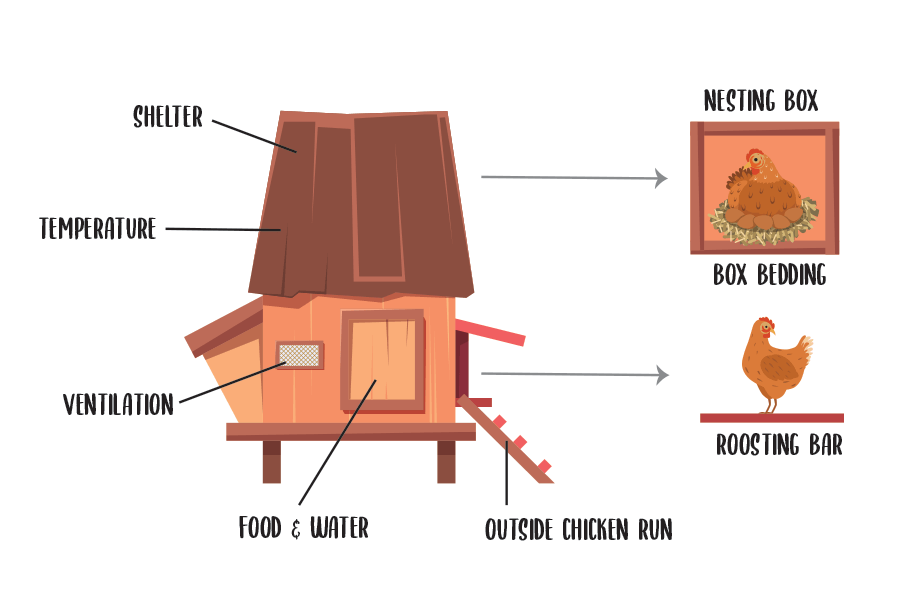
First of all, they need some refreshing sleep.
Chicken Roosts
It’s a chicken’s natural instinct to roost as high as possible. Chickens in the wild sleep on the branch of a tree. They sleep together and sit next to each other on the roosting perch.
In the chicken coop, the roost is usually a branch or perch. You can create your own perch with a wooden beam. Chickens need about 10 inches of perch each to roost comfortably.
Under the roosting bar, foresee a droppings board so you can quickly clean things up.
Now, for the dimensions.
How High should a chicken roosting bar be?
The perches should be at least 1,5 to 3 feet from the ground. Silkies will be happy to roost on 18 inches.
They generally prefer to sit as high as possible, as long as they can reach the perches. You can always create a ladder so they can get up.
Also, ensure they have at least 18 to 24 inches of headspace between the perch and the ceiling of the coop. They need some space to jump on the bar without bumping their head.
The most important part is to have the roosting bars higher than the nesting boxes. They will roost in their nesting boxes if it’s the other way around!
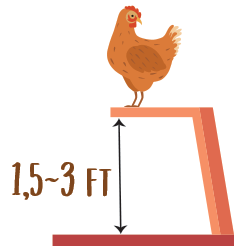
Same Height vs. Ladder
If you place the roosting bars on different levels, they will all try to reach the top. The hens that are lowest in the pecking order will end up at the bottom. Depending on the setup, sometimes they can poop on each other too.
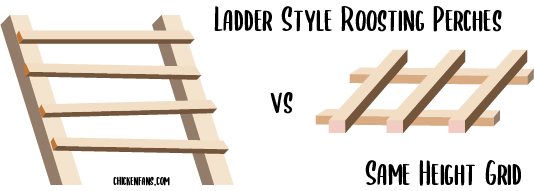
You can eliminate many of these issues by placing the roosting bars all at the same height. When placed at the same height, leave 12 to 16 inches in between to give them some space to settle.
How Big should a chicken roosting bar be?
The roosting bar should be a 2×4 inch wooden beam or similar. The wide side goes on top, so the chickens have a flat surface to sit on, but they can still curl their toes around the edges. It can be any wood, as long as it’s not treated with chemicals.

Hens roost next to each other. Foresee about 8 to 10 inches of space for them to sit comfortably.
Read our complete guide on roosting for more information.
Nesting Boxes
Hens need nesting boxes to lay their eggs. A good rule of thumb is to provide one nest box for every three to four hens. So, if you have six chickens, you can start with two boxes. You can use the chicken coop calculator to calculate the number of nesting boxes you need for your coop.
Nesting boxes are commonly around 12 to 16-inch cubes. The boxes should provide them a safe, cozy space to lay their eggs. The recommendation is to place them in a dark and quiet part of the coop. Some people even hang curtains on their nesting boxes to make them cozy.
Usually, they all want the same nesting box. They will even get in a row and wait for each other to use the popular boxes.
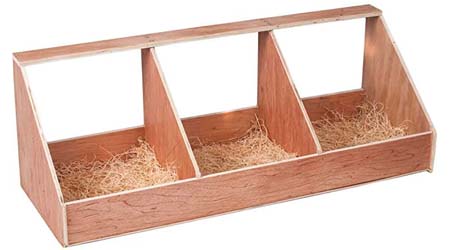
Nesting Box Material
They are generally not too picky about what the box looks like or what it’s made of. Wood, metal, and plastic can all be used.
Wood is sturdy but is prone to bacterial growth. Plastic is less susceptible to bacteria, but make sure to secure the box. People use buckets, barrels, and cat litter boxes; their hens are happy to lay eggs in them.
What bedding is best for Nesting Boxes?
The most popular bedding for nesting boxes is hay, straw, pine or cedar shavings, and sand. All have their pros and cons.
Pine shavings are popular because they soak up spills, dry quickly, are resistant to moisture, and stay pretty fresh. Straw is a cheap alternative but retains moisture and comes with insects and mold.
Hay is another option for nesting boxes, but its greenness makes it a breeding ground for fungi, mold, and bacteria.
An alternative would be to use nesting pads, which allow for quick cleaning. They have openings for moisture disposal, and the plastic won’t deteriorate over time. But they aren’t as cheap as hay or straw. We’ve tested multiple brands, like My Favorite Chicken, Eaton Pet & Pasture, and Cackle Hatchery.
We don’t recommend using shredded newspaper, it sticks to the eggs, and the ink can be toxic. It gets mushy when wet, and the hens drag it all over the place.
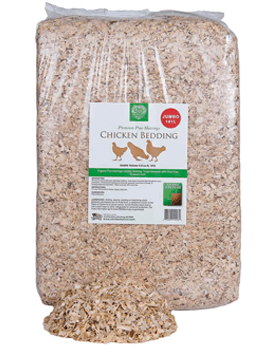
Chicken Coop Bedding
The bedding for the coop is somewhat different from the bedding in the nesting boxes. We don’t recommend hay for chicken coops. It’s too wet, harbors pathogens, and will mold rather than dry out. Straw would be the better option.
The most common beddings are:
- Straw
- Pine shavings or cedar shavings
- Sand
- Shredded paper
All of them are possible and come with their advantages and disadvantages
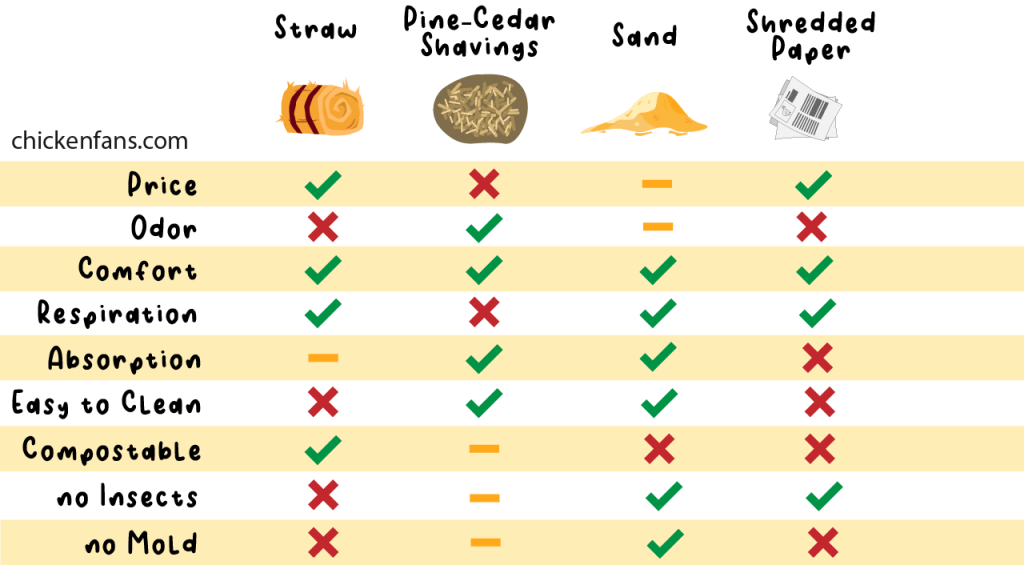
Here are the main takeaways from the in-depth comparison:
- Straw – some people love it, others hate it. It’s a cheap, dry solution that decomposes quickly on the compost pile. However, it’s less absorbent, prone to mold, and harbors insects.
- Pine or Cedar Shavings – became very popular due to their pleasant aroma and excellent absorption. They are easy to clean and compostable but take a little longer to break down. The big disadvantage, however, is that it’s dusty and can irritate the respiratory system of the chickens.
- Sand – is one of the best options in the charts. It’s comfortable, as easy to clean as cat litter, and won’t attract insects. However, it isn’t compostable, and you must turn it over regularly to control the smelliness.
- Shredded Paper – an option we won’t recommend. The ink can be toxic, the paper will stick to the eggs, and the chickens will drag the paper all around the coop. It doesn’t absorb and gets smelly immediately. It is, however, very cheap.
Food and Water
Chickens need access to clean water. They drink about a glass a day, depending on the conditions.
Automatic waterers exist, but a normal waterer suffices for small flocks. You can hang them above the floor. This prevents scratching and spilling over or contaminating the water.
An alternative is to buy some poultry drinking nipples and attach them to the bottom of a bucket or pipe. Not all chickens seem to like them, but it’s a great solution if they do. Make sure to check the nipples now and then because they can get clogged.
As a rule of thumb, full-grown egg layers eat about 1/4 pound of food per day per chicken. In reality, it really depends on the breed and your environment. In normal conditions, you can not overfeed chickens.
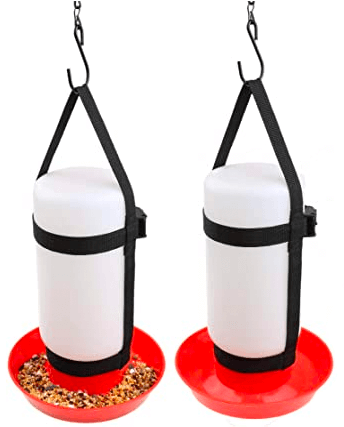
It’s a bit controversial whether to place the food and water inside or outside of the coop. Most people place them outside of the chicken coop. The idea is that the coop is a place to roost and lay eggs and nothing else. Chickens won’t eat or drink at night. You can, however, place water and food inside if you want to keep it dry or keep it from freezing.
Ventilation
Ventilation is crucial for chicken coops and is often overlooked.
Chickens are breathing and pooping, which makes the air humid and increases carbon dioxide and ammonia fumes. Our hens are cold-hardy, but they will suffer from bad air quality. Bad conditions will attract mold and bacteria. When you open the coop in the morning and smell ammonia, you need more ventilation.
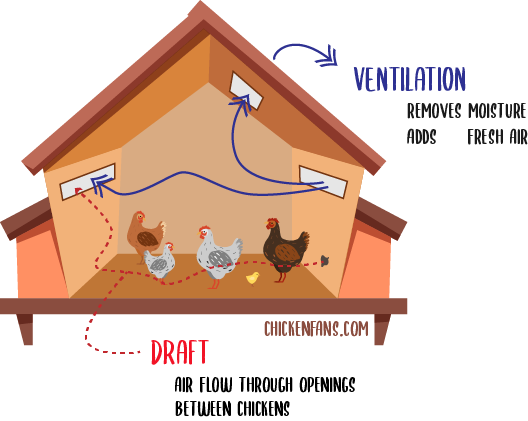
Ventilation goes on the top of the coop, so the ammonia fumes and carbon dioxide can be replaced by fresh air. No airflow should be on the bottom, so your chickens won’t sit in the draft. Especially in the winter, the hens need to stay warm.
Unfortunately, a lot of chicken coops are not sufficiently ventilated at all. Especially in the winter, moist air means frostbitten combs and respiratory problems.
In fact, followers of the Fresh-Air school believe chickens belong outside and build complete open-sided Fresh-Air Poultry Houses.
Temperature Regulation
The chicken coop should be a fresh place in the summer and a warm shelter in the winter.
If they had the choice, most of them would put the thermostat somewhere around 70 degrees Fahrenheit (21°C).
Winter
Chickens are pretty cold-hardy and withstand much lower temperatures than some think. Even if temperatures dip just below freezing, they will still lay their eggs. They will snuggle together and puff their feathers to create an air gap as an insulation layer.
That said, they are no penguins, either. Leghorns used to trip around in the sun on Sicilian hills but are now imported for their egg-laying capabilities in colder climates.
Some breeds just don’t come with the outdoor softshell plumage that is needed to survive at -40°F. They will freeze to death after suffering a long lead of frostbite. Other breeds like the Rhode Island Red, Plymouth Rock, and Australorp are much more cold-hardy.
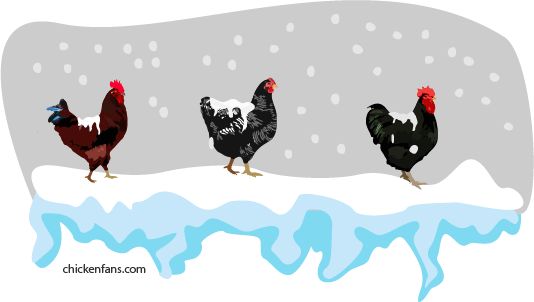
If it becomes too cold or you have sensitive breeds, make sure to heat the coop to prevent freezing. You can use a heat lamp, but it’s not the first time that a coop went up in flames. Safer alternatives are heating pads. Also, make sure the coop is properly insulated.
If ever all hell breaks lose, you can always take them in the garage for a couple of days.
Summer
Whereas chickens are pretty cold-hardy, they are much less able to cope with the heat in the summer. Temperatures over 90 degrees Fahrenheit will make them suffer from heat stress, which can cause organ damage, and egg deformation and lead to death.
They can’t sweat as their body is packed with feathers. They dissipate excess heat from the parts that are not covered: their combs and wattles. The only way to release heat is by panting and spreading their wings.

That’s why breeds with larger combs and fewer feathers are better at coping with the heat. For example, Leghorns, Isa Browns, or New Hampshires have larger combs and wattles and are less prone to overheating.
To make the chicken coop summer-proof, make sure they have some shade available, access to fresh (cold) water, frozen food, and a small pool for water play. Proper ventilation in the coop is key. You can add fans for mechanical ventilation to enhance air circulation.
Location of the Chicken Coop
The best location for your chicken coop will depend on your personal situation. The amount of space you have available, the climate you live in, the orientation of the garden, etc.
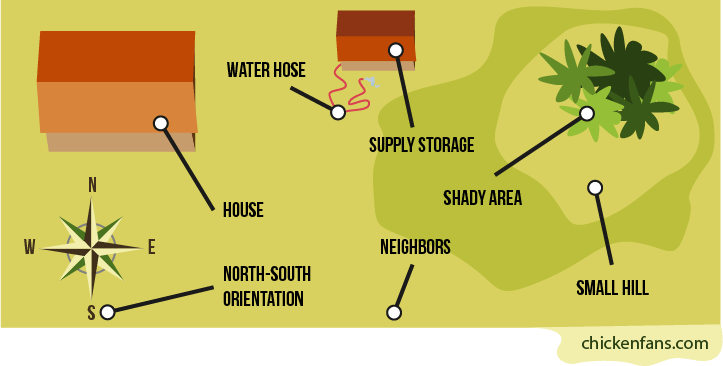
Here are some things to keep in mind:
- half sun, half shade
hens need sun and shade, a location under a tree or half shady is ideal - distance from the house
the coop should be far enough to keep the smell and flies out but close enough to ensure maintenance won’t become a burden - distance from supply storage
if you keep your food, straw, and work materials separate - north or south facing
this depends on your climate; some people need their nest boxes on the southern wall to prevent the eggs from freezing; in warmer climates, it would be the opposite - the proximity of water and electricity
you don’t want to drag buckets of water to the coop every day - noise and neighbors
not all neighbors tend to like noisy chickens - hills and rain
if you’re in a rainy climate, make sure the coop is on top of the hill and not on the bottom, where it can flood
Safety and Protection from Predators
Unfortunately, there are plenty of predators that like chicken for dinner.
Your coop needs to be safe, where predators can’t penetrate by any means. These predators are coming from all directions.
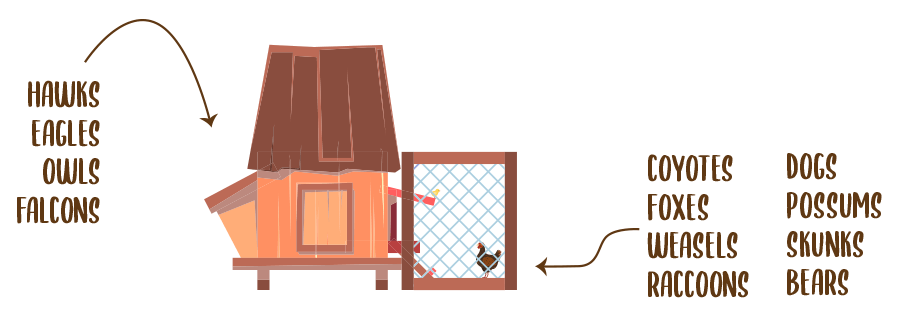
Depending on your location and infiltrators, here are some safety measures you can take:
- bury the fence in the ground
put your shovel in the ground and bury your fence 10 to 12-inches deep to prevent intruders from digging under the fence - use galvanized welded wire mesh
raccoons and foxes can chew through regular chicken wire, so you might opt for a welded alternative with a 1-by-2-inch mesh or smaller - cover the coop
to protect against hawks and owls diving in, cover the run with chicken wire - cover all tiny holes
weasels only need half an inch to enter a coop; oftentimes, they use mouse and rodent tunnels to enter and decapitate your flock (they only kill, they won’t eat them) - put a lock on the chicken coop door
some hunters are smart enough to open doors, so you will need to lock them or get an automatic door - collect your eggs daily
snakes and rats are only interested in the eggs, keep the eggs out to remove any temptation
Automatic Chicken Coop Door
If you want to give your chicken coop a predator-proof upgrade, an automatic coop door is a must. It opens and closes whenever you want and keeps your chickens safely tucked in each night.
With many brands of chicken coop doors on the market, varying in design, price, and functions, it can be difficult to find the door that fits your needs. We’ve thoroughly tested many chicken coop doors and made a list of our Best Automatic chicken coop doors, including major brands like Omlet, ChickenGuard, Vevor, Chickcozy and Run Chicken.
Wrap Up
We’ve covered many topics regarding our beloved chicken coops, but we’d love to hear from you.
What kind of coop did you go for? Do you have any tips for other chicken fans?

